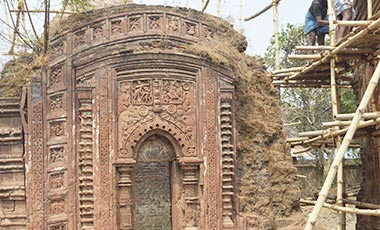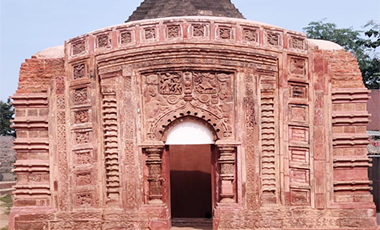Indian Trust for Rural Heritage and Development (ITRHD)
Just as the universe is contained in the self, so is India contained in the villages
- Mahatma Gandhi
Just as the universe is contained in the self, so is India contained in the villages
- Mahatma Gandhi
The village of Maluti, in the state of Jharkhand, is a 6-hour drive from the city of Kolkata. It is an extremely precious heritage site, with 62 terra-cotta temples (17th-19th century) surviving from 108 original structures. The National Geographic has identified Maluti as one of the worlds 12 most important heritage sites in danger of vanishing.
The temples are built in the indigenous style of Santhali / Bengali temple architecture, and display much extremely beautiful terra-cotta sculpture and decorative details. The temples are built in clusters, interspersed with the mud huts of the villagers, also built in traditional vernacular style.The integration of temples with residences make this an extraordinarily rare example of a living "temple village".


ITRHD took the initiative to conserve and protect these unique monuments in 2011. The Global Heritage Fund (GHF) had declared Maluti an endangered site based on an extensive site study by the leading conservation firm of Abha Narain Lambah Associates, and at their request an ITRHD team visited the site. Realizing the historical and cultural importance of these unique and beautiful monuments, their extremely endangered condition, and Maluti's rare character as a living "temple village," during the next few years ITRHD carried out extensive preliminary planning work at its own expense.
In 2015 the Jharkhand Government agreed to fund the entire project, with a budget of Rs. 7 crores. A MoU was signed between ITRHD and the Government of Jharkhand on 29th July 2015. The project was officially inaugurated in October of that year by Prime Minister Narendra Modi, and thereafter work began in earnest.
Work is being carried out by an ITRHD team, under the supervision of ITRHD Trustee Prof. AGK Menon, with monitoring by Abha Narain Lambah Associates. Work is also monitored and the site frequently inspected by a committee formed for this purpose by the Govt. of Jharkhand, consisting of senior bureaucrats and experts in relevant fields.
The village that owns this extraordinary heritage was extremely impoverished. When we began work, there was no electricity, no doctor, no health facility, no sewage system, no safe water supply.
While working on restoration of the temple structures, ITRHD is partnering with the State Government to improve the civic infrastructure, and to create facilities for cultural and religious tourists.


To date these interventions have included:
To ensure the sustainability of the conservation work on a long-term basis, plans are to develop a Training Centre for local youth to give them the skills required for maintenance of the terra-cotta sculptures and structures.


The improved civic infrastructure and new tourism facilities, including an Interpretation Centre, will make Maluti a significant destination for cultural and pilgrimage tourism. The local community also will be trained to manage the tourism facilities, thus creating employment and new opportunities for the community.
Not only will an important heritage site be preserved, but an impoverished rural community will have learned how to successfully manage a previously unrecognized heritage resource, in the process achieving self-sufficiency, improved living conditions, and a new sense of pride as owners of this most precious resource.
